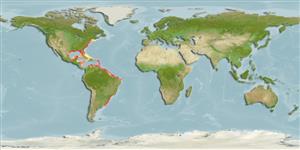>
Eupercaria/misc (Various families in series Eupercaria) >
Sciaenidae (Drums or croakers)
Etymology: Micropogonias: Greek, mikros = small + greek, pogon = beard (Ref. 45335).
More on author: Linnaeus.
Environment: milieu / climate zone / depth range / distribution range
Ekologi
marina; brackvatten bottenlevande; djupintervall ? - 100 m. Subtropical; 43°N - 37°S
Western Atlantic: Massachusetts, USA (excluding Florida) and northern Gulf of Mexico to northern Mexico. Possibly from southern Brazil to Argentina. Uncertain in southern Gulf of Mexico, Lesser Antilles and southern Caribbean (Ref. 26938).
Length at first maturity / Size / Vikt / Age
Maturity: Lm ?, range 18 - ? cm
Max length : 55.0 cm TL hane/ej könsbestämd; (Ref. 40637); common length : 30.0 cm TL hane/ej könsbestämd; (Ref. 3702); publicerad maxvikt: 2.6 kg (Ref. 40637); rapporterad maxålder: 5 år (Ref. 12193)
Adults occur usually over mud and sandy mud bottoms in coastal waters and in estuaries where the nursery and feeding grounds are located. They feed mainly on worms, crustaceans and fishes. An excellent foodfish. Sold fresh and frozen; eaten fried, broiled, microwaved and baked (Ref. 9988).
Life cycle and mating behavior
Könsmognad | Reproduktion | Lek | Ägg | Fecundity | Larver
Robins, C.R. and G.C. Ray, 1986. A field guide to Atlantic coast fishes of North America. Houghton Mifflin Company, Boston, U.S.A. 354 p. (Ref. 7251)
IUCN Red List Status (Ref. 130435)
Threat to humans
Harmless
Human uses
Fiskeri: kommersiell; Vattenbruk: experimentell; sportfisk: ja
Verktyg
Special reports
Download XML
Internet-källor
Estimates based on models
Preferred temperature (Ref.
123201): 14.2 - 27.7, mean 24.1 °C (based on 540 cells).
Phylogenetic diversity index (Ref.
82804): PD
50 = 0.5156 [Uniqueness, from 0.5 = low to 2.0 = high].
Bayesian length-weight: a=0.00851 (0.00774 - 0.00936), b=3.09 (3.06 - 3.12), in cm total length, based on LWR estimates for this species (Ref.
93245).
Trofisk nivå (Ref.
69278): 4.0 ±0.50 se; based on food items.
Resiliens (Ref.
120179): Mellan, lägsta populationsfördubblingstid 1,4-4,4 år (K=0.2-0.27; tm=1-2; tmax=5).
Fishing Vulnerability (Ref.
59153): Low to moderate vulnerability (34 of 100).
Climate Vulnerability (Ref.
125649): High to very high vulnerability (66 of 100).
Nutrients (Ref.
124155): Calcium = 74.3 [40.8, 145.2] mg/100g; Iron = 1.07 [0.56, 1.87] mg/100g; Protein = 20.1 [18.4, 21.7] %; Omega3 = 0.303 [0.149, 0.596] g/100g; Selenium = 26.2 [13.9, 50.6] μg/100g; VitaminA = 16.4 [5.7, 55.5] μg/100g; Zinc = 0.688 [0.492, 1.006] mg/100g (wet weight);
